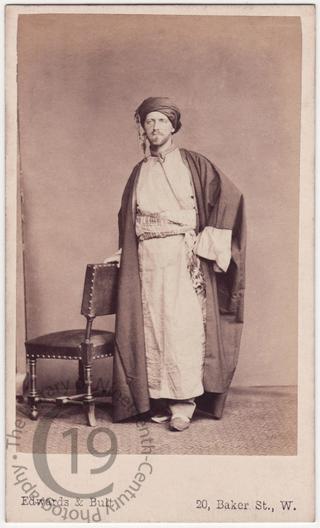
William Gifford Palgrave
The Arabic scholar William Gifford Palgrave (1826–1888) was born in Westminster, the son of Sir Francis Palgrave. He was educated at Charterhouse and Trinity College, Oxford. He went straight from university to India, where he served for a time in the 8th (The King's) Regiment of Foot, Bombay Native Infantry, H.I.C. Shortly after this he became a Roman Catholic, was ordained a priest, and joined the order of the Jesuits, (Society of Jesus), and served as a member of the order in India, Rome, and in Syria, where he acquired a colloquial command of Arabic.
He convinced his superiors to support a mission to the interior of Arabia, which at that time was terra incognita to the rest of the world. He also gained the support of the French emperor, Napoleon III, representing to him that better knowledge of Arabia would benefit French imperialistic schemes in Africa and the Middle East.
Palgrave then returned to Syria, where he assumed the identity of a travelling Syrian physician. Stocking his bags with medicines and small trade goods, and accompanied by one servant, he set off for Najd, in north-central Arabia. He travelled as a Muslim, since to do otherwise would likely have meant death at the hands of angry tribesmen. After travelling for a year from Syria, through Najd, and on to Bahrain and Oman, he returned to Europe, where he wrote a narrative of his travels. The book became a bestseller and has been reprinted many times. It makes no mention of the covert motives for his journey.
In 1865 Palgrave renounced the Church of Rome. He then entered the British Foreign Office and was appointed consul at Sukhum-Kale (Sukhumi) in 1866, and moved to Trebizond (Trabzon) in 1867. In 1868 he married Katherine, the daughter of George Edward Simpson, of Norwich, by whom he had three sons. He was appointed consul at St. Thomas and St. Croix in 1873, Manila in 1876, and in 1878 in Bulgaria, where he was appointed Consul-General. In 1879 he was moved to Bangkok. In 1884 he was appointed Minister Resident and Consul-General to Uruguay, where he served until his death in 1888.
Photographed by Edwards and Bult of 20 Baker Street, London.
Code: 122326




